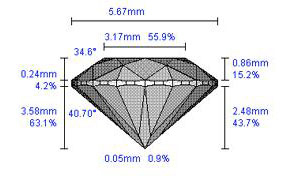About Diamond
-
Introduction
A Diamond is a magical world in itself. Its sheer brilliance will hold anyone spell bound. Since the Diamond is the hardest material known, the Greeks and the Romans called the precious stone adamante (Greek) and adamas (Latin), which both mean 'unconquerable'.
Fortunately, it is not completely unconquerable! Thanks to centuries-old techniques and skills, diamond cutters are able to extract beautiful gems from the rough material.
A Diamond is expensive and precious because of two main reasons. They are: its hardness and its dazzling beauty.
Diamond is a rather rare material. It requires a lot of effort to mine it and then there is still a lot of work needed to turn the rough stone into a sparkling diamond.
But how do you determine the value of a diamond? How do you know, for example, if the diamonds you want to buy are actually genuine?
Zella Diamonds will help you to find answers to these mind boggling questions in a simple way…Zella Diamonds, the diamond exclusive.The classic diamond is, to most people, a round gem of sparkling white brilliance with a kaleidoscope of dazzling facets to entice the eye.
Diamonds are natural crystals of varying size and shape formed in the earth over millions of years. The traditional round brilliant diamond is the most popular diamond shape of all. Diamonds are not all equal. In fact, there are significant differences in quality and, ultimately prices. To understand a diamond's value you must evaluate the diamond under the internally recognized standards of the 4 C's.

-
Clarity
The clarity of a diamond is its innate treasured purity. Almost all diamonds contain minute traces of non-crystallized carbon and other trapped deposits. These tiny birthmarks are known as 'inclusions' .These inclusions are nature's fingerprints and make every diamond quite unique. Diamond clarity is graded from Flawless to Imperfect 3.
Buying Cues: Look out for inclusions hidden by mounting. Try on all ranges of clarity and note the difference. -
Color
From completely colorless to slightly yellow, to brown, these heavenly stars are naturally found in a wide spectrum of hues. They are graded on a color scale which ranges from a purely colorless D to Z (light yellow). A truly colorless diamond is treasured for its rarity. Its true color can be seen when free of any setting which may infuse tints of color into the diamond.
Buying Cues: One should take care to note the setting and the metal. They can either give prominence to the color or de –emphasize it. One should wear the jewellery, as the color can look different against the body. If it's a loose diamond, place it on the top of one's hand and compare it with a mounted stone. -
Carat
The word carat actually comes from the word carob (from carob seeds), which was how ancient civilizations measured the weight of diamonds on their scales. Today, 'Carat' is a unit by which a diamond's weight is measured. Each Carat is divided into 100 parts called 'points'. So a 1-carat diamond has 100 points, a ¾ carat has 75 points and so forth. However, a carat is not a measure of a diamond's size, since cutting a diamond to different proportions can affect its weight.
Buying Cues: Take care to select wisely, the designs and mountings of the jewellery as they can affect the appearance of the stone. A diamond can appear bigger or smaller than its actual weight depending upon its cut. -
Cut
The cut gives each diamond its unique sparkle and brilliance by allowing the maximum amount of light to enter. A well cut diamond does not allow any light to escape offering the greatest brilliance. According to Marcel Tolkowsky(a member of the Belgian family of diamond cutters and an engineer by education and who is generally acknowledged as the father of the modern round brilliant diamond cut), the proportions of an ideal cut (also known as Belgium Cut) are according to those given in the figure below.

-
The fifth 'C' - Certification
A diamond certificate is a report created by a team of gemologists. The diamond is evaluated, measured, and scrutinized using trained eyes, a jeweler's loupe, a microscope, and other industry tools. A completed certificate includes an analysis of the diamond's dimensions, clarity, color, polish, symmetry, and other characteristics. Many round diamonds will also include a cut grade on the report. While purchasing diamond jewellery, insist on certification, especially that of IGI (International Gemological Institute) and for Solitaires, GIA (Gemological Institute of America) certificate is recommended.
Amusing Facts about Diamonds!- In 1000 polished diamonds, only one weighs more than 1 carat.
- The largest rough diamond ever found weighed 3106 carats
- There are over 16,000 different classifications of diamonds.
- Only a diamond can cut another diamond.
- Diamonds are believed to be splinters of stars fallen to the earth.
- It is said that Cupid's arrows are tipped with Diamonds
- Most of the diamonds are over 3 billion years old and the youngest around 100 million.
- Most of the diamonds were formed really deep in the earth, like 100-400 miles deep.
- A 13th century law in France decreed that only the king could wear precious stones.
News & Events

















